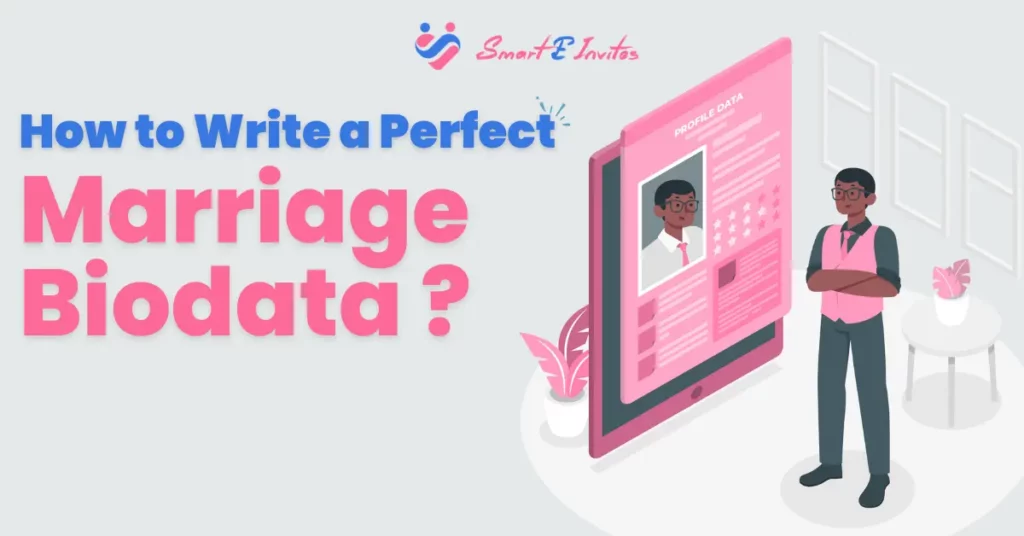In the intricate world of matchmaking, a marriage biodata is your golden ticket to finding the perfect life partner.
It’s not just a piece of paper; it’s your story, aspirations, and personality condensed into a few pages. This comprehensive guide will unravel the art of creating a marriage biodata that truly shines.
The Role of a Well-Crafted Biodata in Finding the Perfect Match
Before diving into the intricacies of creating an impressive marriage biodata, let’s first understand why it’s vital.
In a world where time is of the essence, a marriage biodata serves as your introduction. It’s your first impression of potential partners and can significantly influence the matchmaking process.
Your biodata should reflect your character, values, and aspirations.
Setting the Tone for a Successful Marital Journey
A well-crafted marriage biodata can set the tone for a successful and fulfilling marital journey. It’s not merely about attracting potential partners but finding compatibility and shared values.
Think of it as the foundation upon which your future relationship will be built.
Essential Components of a Marriage Biodata
Your marriage biodata should be more than a mere list of facts; it should be a compelling narrative. Let’s break down the essential components that make your biodata shine.
Personal Information

Crafting the Perfect Introduction
Your introduction is your first impression. It’s the opening scene of your life’s movie. Make it captivating with a touch of humour, humility, and uniqueness. Include your name, age, and a catchy tagline that encapsulates you.
The Significance of an Appealing Photograph
A picture is worth a thousand words; in this case, it’s worth a thousand first impressions. Choose a clear, high-quality photograph that showcases your warmth and approachability.
Providing Accurate Personal Details
Honesty is your best policy. Ensure that all your details, including age, height, weight, and other relevant information, are accurate. Honesty is a sign of respect for potential partners.
Contact Information: Striking the Right Balance
While sharing your contact information is important, balance security and accessibility. Provide an email address or phone number, but avoid revealing too much personal information upfront to protect your privacy.
Family Background
Showcasing Your Family’s Values and Culture
Your family background plays a significant role in your biodata. Highlight your family’s values and culture, offering potential partners insights into the kind of family they might be part of.
Sibling Information: To Include or Not to Include?
Whether to include information about your siblings depends on cultural and personal preferences. Some biodatas have sibling details to provide a holistic family view, while others focus solely on the individual.
Anecdotes that Create a Positive Impression
Share anecdotes or stories that portray your family in a positive light. This could be a family tradition, a memorable event, or any experience that showcases your family’s warmth and togetherness.
Educational and Professional Details
Highlighting Your Academic Achievements
Your educational background is a key element in your biodata. Showcase your academic achievements, including degrees, institutions, and notable honours or awards. This demonstrates your commitment to personal growth and learning.
Describing Your Career Path and Ambitions
When describing your professional journey, focus on growth, challenges, and aspirations. Convey your dedication to your career and your vision for the future.
The Art of Presenting Your Accomplishments
Avoid a simple list of qualifications and work experience. Use storytelling to describe your professional journey, the challenges you’ve overcome, and key accomplishments.
Testimonials and Recommendations
If you’ve received positive feedback or recommendations from colleagues or superiors, consider including them. Testimonials add credibility to your professional narrative.
Hobbies and Interests
How to Make Your Hobbies Reflect Your Personality
Your hobbies and interests provide insights into your personality. Whether reading, sports, or a unique passion, ensure that your hobbies reflect your character and values.
Showcasing Common Interests with Potential Partners
Highlight any hobbies or interests you share with potential partners. Common interests can serve as conversation starters and strengthen your connection.
The Do’s and Don’ts of Listing Your Hobbies
While listing your hobbies, be mindful of cultural sensitivities and potential partners’ interests. Avoid controversial or polarising hobbies in your biodata.
Writing an Engaging Personal Statement

Your statement is where your story truly comes to life, sharing your values and what you’re looking for in a partner. It’s the heart of your marriage biodata.
Crafting an Authentic Introduction
The Power of a Compelling Opening Statement
Your opening statement is your chance to captivate the reader. Use compelling language to convey your uniqueness and the essence of your personality.
Sharing Your Values and Aspirations
Express your core values, aspirations, and what you believe is essential in a successful marriage. This helps potential partners understand your worldview.
Showcasing Your Uniqueness
Celebrate what makes you unique. Embrace your individuality, whether it’s a quirky sense of humour or an unusual talent.
Describing Your Ideal Partner
This section will give you a vivid picture of your perfect match. Be specific but flexible.
Creating a Vivid Picture of Your Perfect Match
Paint a detailed picture of your ideal partner, including qualities, values, and lifestyle preferences.
Compatibility Factors to Consider
Discuss compatibility factors like interests, values, and future goals. This will help potential partners assess the compatibility between you both.
Setting Realistic Expectations
While having standards is essential, it’s equally important to be realistic. No one is perfect, and finding the ideal partner often involves compromises.
Life Goals and Aspirations
Your life goals and aspirations are a crucial part of your biodata. They reflect your vision for the future and can help potential partners understand your priorities.
Aligning Your Future Plans with Your Partner’s
Discuss how your life goals align with what you want in a partner. A shared vision for the future is a strong foundation for a successful marriage.
Balancing Personal and Professional Aspirations
Show how you plan to balance your personal and professional life. This can give potential partners confidence in your ability to manage both.
The Role of Mutual Growth in a Successful Marriage
Highlight the importance of mutual growth in a marriage. Emphasize that you’re open to evolving and adapting as a couple.
What Makes You Tick
This section provides a deeper look into your personality, passions, and dreams.
Revealing Your Passions and Dreams
Share your passions, whether a love for traveling, a creative hobby, or a social cause. This can spark a connection with someone who shares similar interests.
Sharing Anecdotes that Reflect Your Character
Narrate anecdotes or experiences that have shaped your character. This can provide insight into your life journey and values.
The Art of Storytelling in Your Biodata
Use storytelling techniques to make your biodata engaging and relatable. A well-told story can be memorable and endearing.
Also Read – Best Wedding Invitation Templates For A Perfect Wedding: The Ultimate Guide
Presentation and Format
The presentation and format of your marriage biodata are as important as its content. They influence readability and the overall impression you create.
Choosing the Right Template
Exploring Biodata Templates and Styles
Consider various biodata templates and styles. Choose one that resonates with your personality and makes your biodata visually appealing.
Customizing Templates to Reflect Your Personality
Personalize the chosen template to reflect your style. Add unique design elements, colors, and fonts that represent you.
The Importance of Clarity and Readability
Ensure that your bio data is easy to read and navigate. Clarity is key, and a well-structured biodata can leave a lasting impression.
Fonts, Colors, and Formatting
The visual aspects of your biodata matter more than you might think.
The Psychology of Fonts and Colors in Biodata
Different fonts and colors convey other emotions. Choose fonts and colors that showcase your personality and the tone you want to set.
Creating a Visually Appealing Document
Your biodata should be visually appealing. Use a balanced mix of text, images, and colors to make it eye-catching.
The Do’s and Don’ts of Formatting
Pay attention to formatting details. Avoid clutter, excessive bolding, or italics, and maintain a professional look.
Proofreading and Review
Before finalizing your marriage biodata, meticulous proofreading is essential.
The Role of Grammar and Spelling in First Impressions
Grammatical and spelling mistakes can leave a negative impression. Double-check your biodata for any language errors.
Seeking Feedback from Trusted Individuals
Share your biodata with friends or family and ask for their feedback. They might spot things you’ve missed.
Finalizing Your Biodata with Confidence
After thorough editing and proofreading, you can confidently finalize your marriage biodata. It’s now ready to be shared with potential partners.
Online Profiles and Biodata
In the digital age, online profiles play a significant role in matchmaking.
The Role of Online Matrimonial Websites
Navigating the Digital World of Matchmaking
Online matrimonial websites are a popular platform for finding a life partner. Learn how to create an impactful online profile.
Creating an Impactful Online Profile
Your online profile should mirror the content and style of your printed biodata. Consistency is key to a strong online presence.
Safety Tips for Online Interactions
Online safety is paramount. Be cautious about the information you share online and prioritize your privacy.
Beyond the Biodata: Social Media and More
Social media can also influence your matchmaking journey.
The Influence of Social Media on Matchmaking
Potential partners may check your social media profiles. Maintain a positive online presence that reflects your values.
Maintaining a Positive Online Presence
Be mindful of the content you share on social media. It should align with your biodata and reflect your character positively.
The Dos and Don’ts of Digital Etiquette
Practice good digital etiquette when interacting with potential partners online. Respect their boundaries and communicate with politeness and empathy.
Also Read – Best Wedding Invitation Quotes For Your Marriage
Connecting with Potential Partners
Building a connection with potential partners is a critical step in the matchmaking process.
Initiating Conversations and Building Rapport
Initiate conversations with potential partners by showing genuine interest and respect. Building rapport is essential for a successful connection.
The Importance of Open and Honest Communication
Honesty and open communication are the cornerstones of any successful relationship. Ensure that your interactions are transparent and sincere.
Balancing Online and Offline Interactions
While online interactions are convenient, they should ultimately transition to offline meetings. Strike a balance between the two for a well-rounded connection.
Honesty and Transparency
Honesty and transparency are non-negotiable in the matchmaking process.
The Significance of Honesty
Honesty is the foundation of trust. Be truthful in your biodata and all interactions with potential partners.
Building Trust Through Transparency
Transparency fosters trust. Share sensitive information honestly and respectfully.
Addressing Sensitive Topics in Your Biodata
While being honest is important, handle sensitive topics with care and empathy. Approach them with a positive and constructive outlook.
Handling Rejections and Setbacks
Rejections and setbacks are a part of the matchmaking journey, and knowing how to cope is essential.
Coping with Rejection in the Matchmaking Process
Rejections are not a reflection of your worth. Learn to handle them gracefully and use them as opportunities for personal growth.
Learning from Setbacks and Moving Forward
Setbacks can be valuable learning experiences. Use them as stepping stones to finding the right partner.
The Role of Resilience in Finding the Right Partner
Resilience is your strength in the face of adversity. It’s a quality that can help you navigate the ups and downs of the matchmaking process.
The Art of Acceptance
Acceptance is the final piece of the puzzle in the matchmaking journey.
Embracing Differences in Partner Preferences
Every individual is unique, and that uniqueness extends to partner preferences. Embrace diversity and respect others’ choices.
Finding Beauty in Diversity
Diversity is what makes the world beautiful. Celebrate differences and be open to a wide range of possibilities.
The Journey to Mutual Understanding
The path to mutual understanding begins with acceptance. This understanding can lead to a harmonious and fulfilling partnership.
Conclusion
In the quest for a lifelong partnership, your marriage biodata is your ambassador. It’s not just a piece of paper; it’s the beginning of a beautiful journey.
Following the guidelines and tips outlined in this comprehensive guide, you can create a marriage biodata that truly shines.
Remember, your biodata is not just a snapshot; it’s the first chapter of your love story. Happy matchmaking!
FAQs
Ques 1. What is the purpose of a marriage biodata?
Ans. A marriage biodata aims to introduce yourself to potential life partners, providing a snapshot of your character, values, aspirations, and background.
Ques 2. What are the essential components of a marriage biodata?
Ans. The essential components of a marriage biodata include personal information, family background, educational and professional details, hobbies and interests, an engaging personal statement, and details about your ideal partner.
Ques 3. How should I craft the introduction in my marriage biodata?
Ans. Craft your introduction by including your name, age, and a catchy tagline encapsulating your personality with humour and humility.
Ques 4. What is the significance of including a clear, high-quality photograph in a marriage biodata?
Ans. Including a clear and high-quality photograph in your marriage biodata is essential as it gives potential partners a positive first impression and showcases your warmth and approachability.
Ques 5. What should I consider when creating an online matrimonial profile?
Ans. When creating an online matrimonial profile, mirror the content and style of your printed biodata, maintain consistency, prioritize online safety, and maintain a positive online presence aligned with your values.


